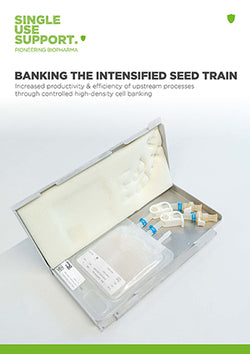Upstream intensification from lab to mAb manufacturing
Upstream process intensification is something you currently hear a lot in the context of upstream bioprocessing (USP) optimization. One of the upstream intensification processes being addressed is seed train intensification. This is the use of high density cell banking to increase time and resources during the cell expansion for monoclonal antibody production. It drives manufacturing efficiency tremendously. And with it: safety, process flexibility and product quality - equivalent to CHO cell recovery. Establishing high density cell banks (HDCBs) is beneficial for current mAb manufacturers, but also for those who will soon be producing mAbs. And as we look at drug product pipelines and patent expiry of blockbuster biologics, the need for antibodies will increase.
Why HDCB in seed train intensification is more relevant than ever
Seed train intensification is a key strategy in upstream bioprocessing, aimed at streamlining biologics production. It focuses on optimizing the early stages of cell culture, particularly through high density cell banking. These banks store concentrated CHO cells, which are subsequently used to inoculate bioreactors, enable faster and more efficient cell cultivation.
Banking CHO cell intermediates is crucial, preserving cells at various growth stages. This ensures a consistent supply of high-quality cells for upstream processes such as N-1 bioreactor perfusion. Advanced aliquoting and cryopreservation techniques maintain cell viability, resulting in high cell recovery rates when Ultra-High Cell Density Working Cell Bank (UHCD-WCB) are thawed for inoculation.

Consequently, viable CHO cells lead to higher mAb yields during production. Intensifying the seed train accelerates cultivation, reduces time-to-market and enhances overall productivity. However, speed is not everything. It also optimizes the entire upstream process. As a result, process intensification helps manufacturers significantly improve efficiency and output, making it an demanded strategy in modern biomanufacturing.
Biosimilars igniting mAb production even more
Already now antibodies are in high demand. They are used to treat a wide range of diseases, including cancer, chronic inflammatory diseases or infectious diseases. Monoclonal antibodies serve as a crucial component for bioconjugates, such as antibody-drug conjugates (ADCs), which precisely deliver cytotoxic drugs to cancer cells, especially in targeted cancer therapies.
The growing importance of mAbs in biomanufacturing is also driven by the rise of mAb-based biosimilars. Due to the soon expiration of patents for mAb therapies, biosimilars will increasingly enter the market. Keytruda (pembrolizumab) and Opdivo (nivolumab) are among the most prominent with patents expiring in 2028.[[1]] Currently the mAb segment captures more than 40% of revenue share in the biosimilar market. [[2]] A similar trend is seen in biosimilar product pipeline with approx. 30% based of antibodies.

Upstream intensification with single-use technology
What is the most efficient way to transfer CHO cells from incoluation or seed train to cell banks? There is still a gap in process solutions for fluid and cold chain management.
The dispensing of CHO cells into single-use cryobags and the subsequent banking of working cells must be performed in an aseptically closed system to minimize the risk of contamination, and to optimize cell viability. The risk of degradation should be reduced as much as possible, which includes too long exposure to ambient temperature after the addition of cryoprotectants, such as DMSO, or uncontrolled freezing and thawing.
Single Use Support’s process solutions meet these requirements. Large single-use source bags of 1L to 20L are aliquoted into dozens of small single-use bags with RoSS.FILL. CHO cells can be cooled during homogenization and during dispensing at the fluid path (RoSS.PADL). The filled cryobags are protected by robust secondary packaging, like RoSS.KSET, to start cryopreservation of the mammalian cells. The RoSS.pFTU as plate freezer and the RoSS.LN2F as liquid nitrogen cryogenic freezer are two methods that perform controlled-rate freeze-thaw cycles that help manufacturers achieve maximum cell viability post-thaw.
With maximum process flexibility based on single-use technology, process engineers and scientists can benefit from the efficiency of seed train intensification whilst maintaining high cell viability. Until now, this has only been promised in theory.
Single Use Support’s bag-independent and scalable process solution is the first for seed train intensification that maximizes cell viability while shortening the time from lab to final mAb.
[[download-1]]
References

Download Guide
Guide: Banking the Intensified Seed Train
High-density cell banking is a crucial step in the seed train intensification process for biopharmaceutical production. To get the train rolling, multiple optimized process units, that enable high cell densities cultivation & efficient high cell density cryopreservation, need to be combined.Download our free Whitepaper and learn more.
